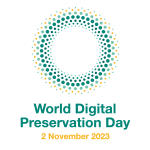 World Digital Preservation Day (#WDPD2023) is celebrated on the first Thursday in November every year. It is a time to spotlight successes in our digital preservation programs and communities, as well as draw attention to those things that are most at risk, such as the DPC’s The Global ‘Bit List’ of Endangered Digital Species. The theme for 2023 is Digital Preservation: A Concerted Effort. This is This is especially true at The Ohio State University’s University Libraries, where this year we saw digital preservation become more than a set of strategies and ethos led by one person; it became department. While over the past six years, as the digital preservation librarian, I have led or co-led efforts to conduct a digital preservation environmental scan, develop a web archiving program, move from policy to ethos, documenting and visualizing workflow and investigating project prioritization, nothing was yet programmatic. With the addition of a digital preservation specialist, Kevin Latta, this year, we have started to turn that corner from theory/policy/strategy to implementation of a program.
World Digital Preservation Day (#WDPD2023) is celebrated on the first Thursday in November every year. It is a time to spotlight successes in our digital preservation programs and communities, as well as draw attention to those things that are most at risk, such as the DPC’s The Global ‘Bit List’ of Endangered Digital Species. The theme for 2023 is Digital Preservation: A Concerted Effort. This is This is especially true at The Ohio State University’s University Libraries, where this year we saw digital preservation become more than a set of strategies and ethos led by one person; it became department. While over the past six years, as the digital preservation librarian, I have led or co-led efforts to conduct a digital preservation environmental scan, develop a web archiving program, move from policy to ethos, documenting and visualizing workflow and investigating project prioritization, nothing was yet programmatic. With the addition of a digital preservation specialist, Kevin Latta, this year, we have started to turn that corner from theory/policy/strategy to implementation of a program.
A foundational component of this program is the development of the Gray Digital Preservation Repository. The Gray Repo is service that provides a path to preservation for born digital content that has been accessioned by the University Libraries. Unlike our Digital Collections platform that serves as a “light archive” where patrons/researchers/users can interact with the digital objects (for the most part), the Gray Repo is a “dim archive” that allows for curatorial deposit and retrieval, but no direct patron access, essentially a virtual version of our Book Depository, where our special collections analog materials are managed and stored. In addition to being the default depository for born digital accessions, there will be a handful of other use cases for digital preservation, such as preservation files for digitized legacy Knowledge Bank content and temporally restricted content.
After many fits and starts with testing tools for pre-ingest analysis and ingest, we are currently in the final stages of documenting workflow, and conducting curatorial workflow testing. Our colleagues in the University Archives are our key testers. The development of the Gray Repo has been a concerted effort with contributions from our fellow University Libraries’ IT units: Digital Initiatives, Infrastructure, and Application Development and Operations; as well as input from our colleagues in Special Collections and Archives, Archival Technical Services, Metadata Initiatives, Publishing and Repository Services and Copyright units. Further, we received guidance and input from our colleagues in the Big Ten Academic Alliance and the NDSA.
With the imminent launch of the Gray Repo, the Digital Preservation Department will pivot to begin conducting bench-marking activities utilizing such tools as NDSA’s Levels of Digital Preservation and DPC’s Rapid Assessment Model (RAM). This won’t be just the “department of two” working in a vacuum, but a concerted effort that will engage many of our same colleagues identified above.
